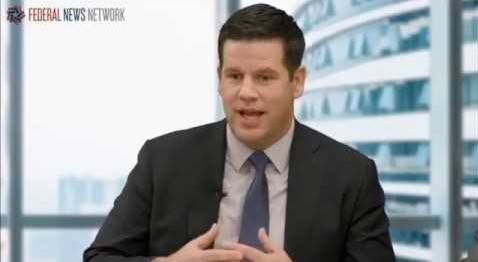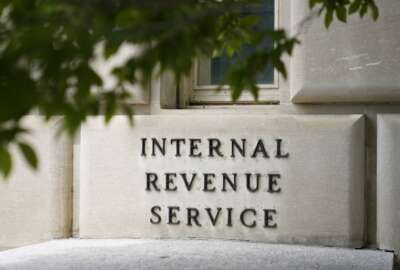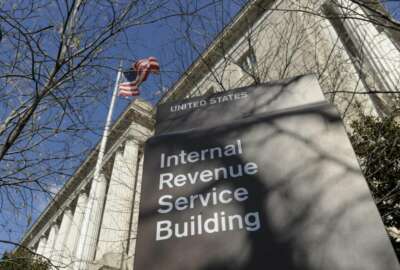

Harrison Smith, the director of the Enterprise Digitization Office at the IRS, said the tax agency is preparing for the influx of new funding by identifying small,...
The Enterprise Digitalization Office at the IRS is less excited about the tens of billions of dollars Congress authorized in the Inflation Reduction Act. What gets Harrison Smith, the office’s director, and the team going is strategic objective 1.2 — the digitalization initiative.
Smith said one such project, the digital intake initiative, is demonstrating what is possible in the near term.
The year-old initiative is fairly straight forward, taking paper tax turns, extracting machine readable data from them and electronically filing them.

“We started in a very small and a very targeted fashion. It was successful. It was difficult. We ran into wrinkles that we expected and we ran into wrinkles that we didn’t expect, and ultimately we continued to learn and scale. Now this year, I believe that we’re at north of 120 times, not 120% increase, but 120 times over what we did last year,” Smith said in an interview with Federal News Network after speaking at the recent ACT-IAC Emerging Technology and Innovation conference. “We are expanding that to different types of forms, expanding that to other data fields and it has been an area where we continue to support. But ultimately, that’ll be a space for another office to continue to scale and to grow. We’re just not built a resource that way, and that’s okay. It’s intentional, but it’s an exciting space around digital and technology.”
The IRS leaned on years of experiences from other agencies such as the Veterans Affairs Department, to see how it could apply both technology and training of its processors.
Smith said the digitalization office went out to industry seeking help and didn’t try to be prescriptive, but just offered up the problem they were trying to solve.
“If you are an e-filer and you submit something that doesn’t have a zip code, you will not be able to submit it right. It will say error, and we’ll kick back out. But paper has a different set of rules. So you’re straddling the paper rules, and the e-file rules,” Smith said on Ask the CIO. “You’ve got to figure out a way if somebody submitted a paper return that didn’t have a zip code to manage that. You don’t return it to them. There’s a technology conversation around some of the business rules about how things get worked. But there’s also a business process rule, because if it’s coming in and paper, there’s a designated space for where those types of items get identified. But because it’s a different process and because it’s different space, you’ve got to make sure you piece those together.”
Smith said the digital intake initiative demonstrates what the IRS can do with a little innovation and small amount of money.
“We are an enabler. We are a trampoline. We are a rocket booster for what any of our teams want to do. We help them work on the challenges that are highlighted in the strategic operating plan and we really do focus on the innovative aspects, driving what works, driving results and then being able to shift it over to folks for long term implementation,” he said. “There are spaces and opportunities, where it’s the right time, the right set of data and the right use case to pursue because you don’t start with the most complicated one, even if it’s got the greatest return on investment. You start with the simplest one that you can figure out the best, the most clear set and most actionable information as early on as possible. You don’t want to start with the elephant and try to swallow the whole thing, right? If we’re successful, how does it scale into other challenges and other problems? And that’s really the magic sauce.”
To continue to find success with innovative ideas, Smith said the goal is to create trust and engage the business owners. He said he is pro digitization and not anti-status quo.
“Work like this is hard, and everyone is very passionate about the mission. But changing how we perceive things and what we’re willing to try and how we’re willing to try that requires kindness and focusing on what we can do, not lamenting on how we got here. There’s that partnership and that conversation, which ultimately enables and fosters more innovation,” he said. “The best way to identify if something is working, if something is resonating with folks, is when more and more people ask about it, and more and more people want to pursue it. That’s the really great space that we’re in right now. We’ve been supporting other teams, and they’ve said, ‘Hey, can we do this again.’ That’s a great space to me because it’s allowing them to perform their job in a more effective and efficient fashion. And if we’re doing that, it’s a homerun.”
The Office of Digitization will continue to build on its successes. Smith said the team recently issued solicitations for artificial intelligence and machine learning capabilities, as well as robotics process automation tools to improve the taxpayer experience on mobile phones.
He said a significant portion of citizens already come to the IRS website through a mobile device so improving their experience is a priority.
“How do we take advantage of that opportunity and the wealth of information that’s available on IRS.gov? That’s Karen Howard [executive director of Online Services] and her team. They do a fantastic job there. But how do we potentially look at that and say, ‘Hey, how do we access that information? How do we do it the right way?’ I think what becomes most interesting in this space is that it requires us to try something in a space that is not going as far as we can,” he said. “How do we start this at the smallest possible way so we can get the decisions and the information in order to make an informed decision? Because if you start big, you’re not going to get to find out where you are, how much it’s going to cost, how well it’s going to do until much later. We really try to truncate that period of time so that we can make decisions about what’s failing and what’s doing well that we can scale.”
Copyright © 2025 Federal News Network. All rights reserved. This website is not intended for users located within the European Economic Area.
Jason Miller is executive editor of Federal News Network and directs news coverage on the people, policy and programs of the federal government.
Follow @jmillerWFED



